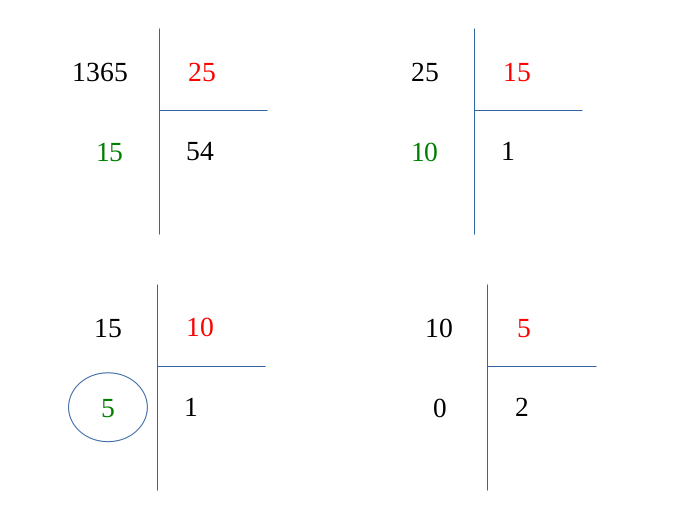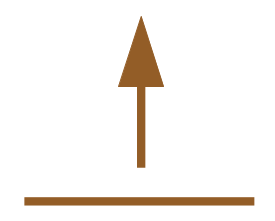



Soient \( (a, b) \in \hspace{0.04em}\mathbb{N}^2, \enspace a > b \).
L'algorithme d'Euclide nous dit que :
Le \( PGCD(a, b) \) est le dernier reste non nul \( R_n \) de la division euclidienne de \( a \) par \( b \) tel que :
Tant que le reste ne divise pas le diviseur de la division précédente, on continue l'algorithme.
On redécompose alors à chaque étape le nouvel élément :
Tant que le reste \( R_{n - 1} \) ne divise toujours pas \( R_{n - 2} \), le reste \( R_{n - 2} \) peut s'écrire :
Jusqu'au moment où enfin \( R_n \) divise \( R_{n - 1} \), alors \( R_{n - 1} \) s'écrira :
À ce moment, par remontée de l'algorithme en injectant tour à tour les valeurs précédentes jusque \( a \) et \( b \), on se rendra compte que l'on pourra toujours factoriser par \(R_{n} \). Et alors :
\( \forall n \in \mathbb{N}\), \(\forall k \in [\![0, n ]\!] \), tant que le reste \(R_{k} \) ne divise pas le reste \(R_{k -1 } \) :
Soient deux entiers naturels \( (a, b) \in \hspace{0.04em} \mathbb{N}^2 \), avec \( a > b \).
Alors, \( a \) s'écrit :
Et à ce moment-là, comme \( b /a \) et \( b/b \), alors \( PGCD(a, b) = b\).
Dans ce cas, \( a \) peut s'écrire sous la forme :
Alors, manière générale,
Alors \( b \) s'écrit :
On peut remonter l'algorithme et injecter \( (b) \) dans \( (a^*) \) :
Soit,
On a alors,
$$ \Biggl \{ \begin{gather*} a = Q_{a}R_0 \qquad (a') \\ b = q_1R_0 \qquad (b) \end{gather*} $$
Et à ce moment-là, comme \( R_0 /a \), \( R_0/b \) et \( R_0/R_0 \), alors :
Dans ce cas, \( b \) peut s'écrire sous la forme :
Alors \( R_0 \) s'écrit :
On peut remonter l'algorithme et injecter \( (R_0) \) dans \( (b^*) \) :
Soit,
On remonte encore une fois en injectant cette fois la nouvelle valeur de \( (b') \) et de \( (R_0) \) dans \( (a^*) \) :
On a alors,
$$ \Biggl \{ \begin{gather*} a = Q_{a}R_1 \qquad (a') \\ b = Q_{b}R_1 \qquad (b') \end{gather*} $$
Et à ce moment-là, comme \( R_1 /a \), \( R_1/b \), \( R_1/R_0 \) et \( R_1/R_1 \), alors :
Dans ce cas, \( R_0 \) peut s'écrire sous la forme :
On continue l'algorithme comme cela jusqu'à ce que \( R_n \) divise \( R_{n- 1} \) et à ce moment-là :
Ainsi, par remontée on aura :
Par suite, on a une réaction en chaîne jusqu'au début de l'algorithme :
\( R_n \) sera alors le plus diviseur commun à tous ces nombres.
Et finalement,
\( \forall n \in \mathbb{N}\), \(\forall k \in [\![0, n ]\!] \), tant que le reste \(R_{k} \) ne divise pas le reste \(R_{k -1 } \) :
Ce reste \( R_n \) pourra lui-même se décomposer en différents facteurs, qui composeront l'ensemble des diviseurs de \( a \) et de \( b \) :
On a vu avec l'algorithme qu'il va falloir effectuer des divisions successives, afin de récupérer le dernier reste non nul de cette série de division.
Calcul de \( 1365 / 25 \)
\( 25 \) ne divise pas \( 1365 \), car cela ne tombe pas juste. On récupère d'abord sa partie entière.
|
$$ \hspace{0.8em } \textcolor{#6187B2}{ \overset{\LARGE\frown}{1 \ 36} }5 $$
|
$$ \textcolor{#AF5F5F}{25} $$
|
|---|---|
|
$$ \hspace{-0.2em } -1 \ 25 \hspace{0.04em} . \hspace{0.2em} $$
|
$$ 54 $$
|
|
$$ \hspace{-0.4em } = \textcolor{#6187B2}{ \overset{\LARGE\frown}{115}} $$
|
|
|
$$ \hspace{-0.2em } -100 $$
|
|
|
$$ \hspace{-0.2em } = \textcolor{#4A8051}{15} $$
|
Alors \( 1365 \) peut s'écrire :
Calculons le reste \( \textcolor{#4A8051}{R_0} \).
Soit,
Calcul de \( 25 / 15 \)
\( 15 \) ne divise pas \( 25 \).
|
$$ \hspace{0.8em } \textcolor{#6187B2}{ \overset{\LARGE\frown}{25} } $$
|
$$ \textcolor{#AF5F5F}{15} $$
|
|---|---|
|
$$ -15 $$
|
$$ 1 $$
|
|
$$ \hspace{-0.2em } = \textcolor{#4A8051}{10} $$
|
Alors \( 25 \) peut s'écrire :
Calcul de \( 15 / 10 \)
\( 10 \) ne divise pas \( 15 \).
|
$$ \hspace{0.8em } \textcolor{#6187B2}{ \overset{\LARGE\frown}{15} } $$
|
$$ \textcolor{#AF5F5F}{10} $$
|
|---|---|
|
$$ -10 $$
|
$$ 1 $$
|
|
$$ \hspace{0.2em } = \textcolor{#4A8051}{5} $$
|
Alors \( 15 \) peut s'écrire :
Calcul de \( 10 / 5 \)
Cette fois-ci, \( 5 \) divise \( 10 \). Le reste est nul.
|
$$ \hspace{0.8em } \textcolor{#6187B2}{ \overset{\LARGE\frown}{10} } $$
|
$$ \textcolor{#AF5F5F}{5} $$
|
|---|---|
|
$$ -10 $$
|
$$ 2 $$
|
|
$$ \hspace{0.2em } = \textcolor{#4A8051}{0} $$
|
Alors \( 10 \) peut s'écrire :
On a donc comme résultat final :

On peut éventuellement remonter l'algorithme et trouver deux nombres qui conviennent à l'indetité de Bézout.
Ce théorème nous dit que :
Pour cela, on va à chaque fois réinjecter les valeurs dans les résultats du calcul précédent.
$$ \Biggl \{ \begin{gather*} \underline{10} \hspace{0.1em} = \textcolor{#AF5F5F}{5} \times 2 \qquad (R_1) \\ 15 = \hspace{0.1em} \underline{\textcolor{#AF5F5F}{10}} \hspace{0.1em} \times 1 + \textcolor{#4A8051}{5} \qquad (R_0) \end{gather*} \enspace \Longrightarrow \enspace 15 = \textcolor{#AF5F5F}{(5 \times 2)} \times 1 + \textcolor{#4A8051}{5} \qquad (R_0') $$
On isole la valeur du \( PGCD \) car c'est elle qu'on veut à la fin comme résultat.
Ensuite, on a :
Avec l'injection de \( (R_1') \) dans \( (R_2) \), on a :
$$ \Biggl \{ \begin{gather*} \textcolor{#4A8051}{5} = 15 - \hspace{0.1em} \underline{ \textcolor{#AF5F5F}{10} } \hspace{0.1em} \times 1 \qquad (R_2) \\ \hspace{0.1em} \underline{ \textcolor{#4A8051}{10} } \hspace{0.1em} = 25 - \textcolor{#AF5F5F}{15} \times 1 \qquad (R_1') \end{gather*} \enspace \Longrightarrow \enspace \textcolor{#4A8051}{5} = 15 - ( 25 - \textcolor{#AF5F5F}{15} \times 1 ) \times 1 \qquad (R_2') $$
Encore, on a :
Avec la double injection de \( (R_0'') \) dans \( (R_2') \), on a :
$$ \Biggl \{ \begin{gather*} \hspace{0.1em} \underline{ \textcolor{#4A8051}{15} } \hspace{0.1em} = 1365 - \textcolor{#AF5F5F}{25} \times 54 \qquad (R_0'') \\ \textcolor{#4A8051}{5} = \hspace{0.1em} \underline{ 15 } \hspace{0.1em} - ( 25 - \hspace{0.1em} \underline{ \textcolor{#AF5F5F}{15} } \hspace{0.1em} \times 1 ) \times 1 \qquad (R_2') \end{gather*} \enspace \Longrightarrow \enspace \textcolor{#4A8051}{5} = 1365 - \textcolor{#AF5F5F}{25} \times 54 - ( 25 - ( 1365 - \textcolor{#AF5F5F}{25} \times 54 ) \times 1 ) \times 1 \qquad (R_2'') $$
Soit,
On a bien :
$$ avec \ \Biggl \{ \begin{gather*} u = 2 \\ v = -109 \end{gather*} $$
 Retour en haut de page
Retour en haut de page